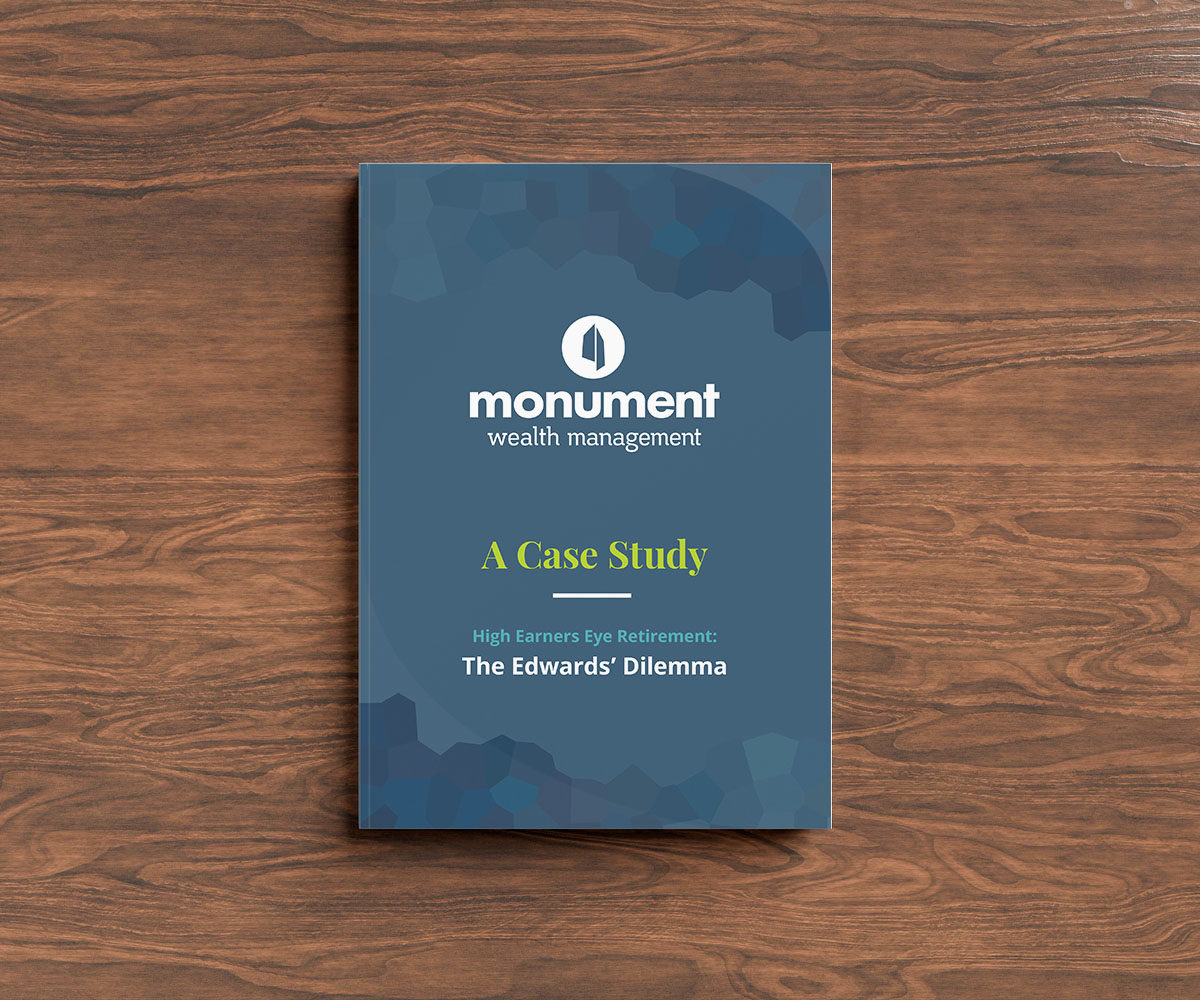Monument Resource Center
Our clients hire us because they recognize the value of our Team’s unique, straight-forward, unfiltered opinion and our tailored advice designed to answer their questions, not everyone else’s. Below, you’ll find some of the most important questions we have been asked over the years to help you better understand the role we play and the advice we give.
Picture this scenario: You worked hard for decades. You took advantage of every retirement savings opportunity you could. You contributed the maximum amount to your retirement accounts for the majority of your career. Due to compound growth on tax-deferred money, you’ve built up a substantial retirement nest egg.
Now you’re retired and you’ve reached the age you need to begin taking Required Minimum Distributions (or RMDs) from your non-Roth retirement accounts. And, because you’ve saved so much money in retirement accounts, your RMD is a lot of money—in fact, more money than you actually need to live on.
Sound like you, or the path you’re headed down? The good news is you have options.
It’s Called “Minimum” for a Reason
I know the question you’re probably asking yourself: Can’t I just take a smaller RMD?
The answer is no.
RMD is just like how it sounds–it is the minimum amount you need to take from your retirement account each year. Bluntly, it’s the IRS’s way of forcing you to take a certain amount of money from your tax-deferred retirement accounts so that they can get their taxes-owed.
RMDs are calculated based on the value of your non-Roth retirement accounts as of December 31 the previous year, then divided by a payout factor based on your age. As you age, the payout factor changes in order to increase your RMD.
When you take your RMD, you will owe ordinary income tax on the amount of money distributed (both federal and state, if you live in a state with income tax). The taxes can either be withheld from your RMD (meaning you will get a smaller amount of money in your bank account) or you can plan to pay the taxes when you file your annual income tax return.
What You Can and Can’t Do
Once you’ve taken your RMD and paid ordinary income taxes on that distribution, it’s your money to pretty much do what you please with.
- Want to reinvest it in your taxable (aka non-retirement) investment account? Sure.
- Want to keep it in cash for emergencies or unexpected medical expenses? Sure.
- Want to donate that money to charity? Sure. (But see below for a possibly better option.)
Want to gift it to someone? Sure. You can gift up to $17,000/year in 2023 ($18,000/year in 2024) to an individual without having to file a gift tax return.
What can’t you do?
Reinvest your RMD back in a retirement account.
You can only add money to a retirement account if you have earned income—meaning you went to work and earned the money (not investment income). Plus, you really wouldn’t want to do this anyway–despite the lure of tax-deferred growth, by adding money back to a retirement account you would theoretically have to pay ordinary income tax again when you take money out of the account. Plus, you would be increasing your future RMDS because you’re increasing the account value.
Are you RMD-age or older and still working? While you need to take RMDs from your IRA accounts (including SEPs and SIMPLE IRAs), you do not need to take RMDs from your employer-sponsored retirement plan (401k, 403b, profit-sharing, or other defined contribution plan). The exception to this rule, however, is if you are a 5% or more owner of the company, you must start RMDs at your RMD-age from your work retirement plan.
Still Looking to Avoid RMDs?
You have two options:
Option 1) Roth conversion
Roth IRAs do not require withdrawals (aka RMDs) until after the death of the owner. The IRS got its tax money from you when you made the contribution, so they don’t care if you do or don’t take money out of your Roth IRA in retirement.
If your retirement money is in tax-deferred accounts, you can convert that money to a Roth at any time, but the tax consequences of this decision need to be carefully considered.
Option 2) Qualified Charitable Distributions (QCDs)
QCDs are a way for retirees to donate their RMD directly from their retirement account to charity. This allows them to avoid paying ordinary income taxes on that RMD while supporting their favorite non-profit organizations. If you’re charitably inclined, this can be a great—and often overlooked—option.
Need Help Figuring Out What Your RMD May Be?
Monument can help. Even if you’re decades from RMD age, Monument can use our planning and modeling software to project what your RMD requirement may be and review different courses of action, such as the impact of doing incremental Roth conversions in the years between when you retire and when you start RMDs (when your tax bracket may be lower).
Don’t worry, we don’t fit the sales-y stereotype. We’re more focused on offering straightforward advice that removes the anxiety of the unknown. Let us help you get clarity on your financial future.

Read our case study, “The Confidence to Sell a Business” to learn how we helped a business owner like you prepare for their sale
Ready for straightforward, unfiltered opinion and tailored advice for YOUR questions, not everyone else’s?
IMPORTANT DISCLOSURE INFORMATION
Please remember that past performance is no guarantee of future results. Different types of investments involve varying degrees of risk, and there can be no assurance that the future performance of any specific investment, investment strategy, or product (including the investments and/or investment strategies recommended or undertaken by Monument Capital Management, LLC [“Monument”]), or any non-investment related content, made reference to directly or indirectly in this blog will be profitable, equal any corresponding indicated historical performance level(s), be suitable for your portfolio or individual situation, or prove successful. Due to various factors, including changing market conditions and/or applicable laws, the content may no longer be reflective of current opinions or positions. Moreover, you should not assume that any discussion or information contained in this blog serves as the receipt of, or as a substitute for, personalized investment advice from Monument. To the extent that a reader has any questions regarding the applicability of any specific issue discussed above to his/her individual situation, he/she is encouraged to consult with the professional advisor of his/her choosing. No amount of prior experience or success should be construed that a certain level of results or satisfaction will be achieved if Monument is engaged, or continues to be engaged, to provide investment advisory services. Monument is neither a law firm nor a certified public accounting firm and no portion of the blog content should be construed as legal or accounting advice.
A copy of the Monument’s current written disclosure Brochure discussing our advisory services and fees is available for review upon request or at www.monumentwealthmanagement.com/disclosures. Please Note: Monument does not make any representations or warranties as to the accuracy, timeliness, suitability, completeness, or relevance of any information prepared by any unaffiliated third party, whether linked to Monument’s website or blog or incorporated herein, and takes no responsibility for any such content. All such information is provided solely for convenience purposes only and all users thereof should be guided accordingly.
Historical performance results for investment indices, benchmarks, and/or categories have been provided for general informational/comparison purposes only, and generally do not reflect the deduction of transaction and/or custodial charges, the deduction of an investment management fee, nor the impact of taxes, the incurrence of which would have the effect of decreasing historical performance results. It should not be assumed that your Monument account holdings correspond directly to any comparative indices or categories. Please Also Note: (1) performance results do not reflect the impact of taxes; (2) comparative benchmarks/indices may be more or less volatile than your Monument accounts; and, (3) a description of each comparative benchmark/index is available upon request.
Please Remember: If you are a Monument client, please contact Monument, in writing, if there are any changes in your personal/financial situation or investment objectives for the purpose of reviewing/evaluating/revising our previous recommendations and/or services, or if you would like to impose, add, or to modify any reasonable restrictions to our investment advisory services. Unless, and until, you notify us, in writing, to the contrary, we shall continue to provide services as we do currently. Please Also Remember to advise us if you have not been receiving account statements (at least quarterly) from the account custodian.
